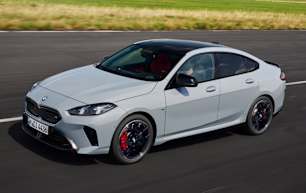Tricky one, this.
Kicking off from $87,800 (all prices are before on-road costs), the EQB 250 front-wheel drive is nearly $24,000 more expensive than the 1.3-litre turbo petrol-powered GLB 200 FWD equivalent.
From a numerical power-output point of view, however, the GLB 250 4Matic (which adds a 2.0-litre turbo petrol engine and all-wheel drive) only costs $10,265 less, which evens things out a bit more.
But wait. To match the GLB 250 4Matic spec, you’ll need to tick the $2900 third-row seats option box in the EQB 250, while AWD is unavailable, even as an option.
An electrified future comes neither cheap nor without compromise, no matter how much you frame it.
At least that $87,800 (which sits neatly between the EQA and EQC EV SUVs) does bring some interesting technology, starting with a 140kW electric motor mounted up front, as well as a sizeable 66.5kWh battery with a rated range of up to 371km (WLTP).
For more power and AWD, you’ll need the EQB 350 4Matic priced from $106,700, adding a second, rear-mounted electric motor for all-wheel-drive traction, upping the power output ante to 215kW, though range drops slightly to 360km.
But the latter is not available in seven-seat form as in some overseas markets, due to weight-related packaging safeguards. Sorry. It’s 250 or nothing if you need a third row.
On the safety front, you’ll find Mercedes’ Driver Assistance Package that includes autonomous emergency braking, blind-spot monitoring, lane-keep assist and adaptive cruise control, as well as evasive steering and a ‘Parking Package’ featuring front and rear parking sensors and a surround-view camera.
Both models also boast LED headlights with high-beam assist, keyless entry/go, a Nappa-sheathed leather wheel, two 10.25-inch digital screens (for instrumentation and multimedia touchscreen), artificial leather upholstery, electric and heated front seats, dual-zone climate control, ambient lighting, ‘Hey, Mercedes’ voice control, a 10-speaker audio system, digital radio, wired Apple CarPlay/Android Auto, a wireless smartphone charger, a sensor-activated powered tailgate and alloy wheels (19-inch on 250 and 20-inch on 350 4Matic).
Keep in mind too that adaptive dampers are standard across the range.
Along with that second motor and AWD, the EQB 350 4Matic also adds a panoramic sunroof, sports seats, microfibre trim inserts, a flat-bottom steering wheel, illuminated door sills, a top-stitched dash and an AMG body kit.
For its first year on sale, the Edition 1 ($9100 extra on 250 and $3900 more on 350 4Matic) ushers in the AMG body kit on 250, Gold Rose 20-inch alloys, a Night Package with darkened highlights, illuminated sills, unique colour leather trim and vents, a different key, AMG mats and backlit interior elements.
Buyers of the EQB 250 can also choose other packs including an AMG Line Sports Package for $4300 and a $3000 Vision Package brandishing a Burmester audio upgrade and sunroof, while both models can be had with a $2500 MBUX Innovation pack offering a head-up display, MBUX Interior Assist that ‘senses’ hand gestures for the touchscreen and other functions, as well as MBUX Augmented reality for the standard navigation system.
At these prices, we'd argue they ought to be standard on every EQB...
There’s also a Mercedes-endorsed Wallbox option from $1710 if your home/work residence qualifies, bringing a Type 2 AC Charger, 22kW, single-phase and three-phase charging. A free Chargefox subscription is also expected to be announced shortly.
Direct, all-electric EQB rivals are very thin on the ground. Those optional third-row seats on the 250 are unique in the sub-$100K EV SUV field, with only the larger and more-expensive Tesla Model X offering the same. For now.
The EQB 350 4Matic, meanwhile, might offer a surprising amount of space and practicality, but at its six-figure starting price, it seems expensive for what you get.







